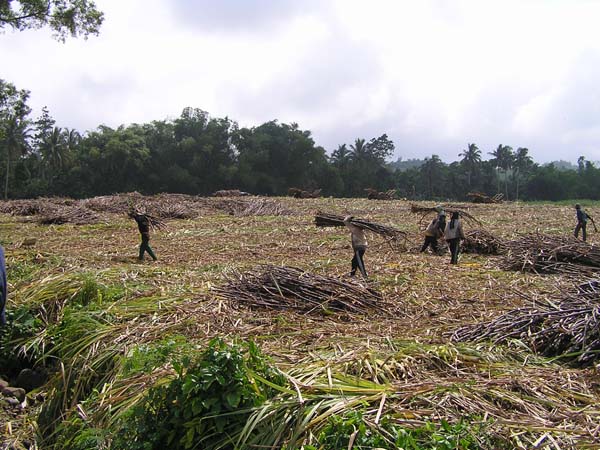 There are only a few hectares left. The last parcels are being harvested. The dry season has started, and the summer sun is beating down on the sakadas. They hack away at the canes, piling them neatly in rows between the canes. They will carry these to the carabao sleds, which will fill up with harvested cane, which in turn will take them to the trucks. The sakadas will then load them in neat stacks, and the truck, once it is full, will then deliver it to Central Azucarera de La Carlota for milling. And this is how it goes every day, since November, when they started harvesting sugar cane in Hacienda Dos Marias.
There are only a few hectares left. The last parcels are being harvested. The dry season has started, and the summer sun is beating down on the sakadas. They hack away at the canes, piling them neatly in rows between the canes. They will carry these to the carabao sleds, which will fill up with harvested cane, which in turn will take them to the trucks. The sakadas will then load them in neat stacks, and the truck, once it is full, will then deliver it to Central Azucarera de La Carlota for milling. And this is how it goes every day, since November, when they started harvesting sugar cane in Hacienda Dos Marias.But once in a while, something disrupts the monotony of harvest—maral kittens! This is how it was for a group of sakadas on Parcel 15 earlier this afternoon. They came upon a ‘nest’, under a clump of cane. Either the mother has abandoned her kittens, or she left them there to hunt for food. The sakadas got the kittens, and because they were already feisty, one of them tied each of the kitten’s legs and put them in his rucksack. He surrendered the kittens to the Maral Project, and we turned it in to the Negros Forests & Ecological Foundation, Inc. (NFEFI) in Bacolod. But some kittens, or mothers, are not so lucky.
 Often, when a nest is uncovered, and the mother chooses to fight, she gets killed by the cane cutters. Kittens are taken home by the cutters, sometimes divided up amongst themselves when there is more than one kitten. Some of them turn up in the local wet markets being sold as pets, while others were simply brought home to the children. Either way, these cats do not survive because they are fed table scraps, and children can sometimes be cruel to animals. At about three to four months of age, these kittens start getting feisty, and can no longer be petted.
Often, when a nest is uncovered, and the mother chooses to fight, she gets killed by the cane cutters. Kittens are taken home by the cutters, sometimes divided up amongst themselves when there is more than one kitten. Some of them turn up in the local wet markets being sold as pets, while others were simply brought home to the children. Either way, these cats do not survive because they are fed table scraps, and children can sometimes be cruel to animals. At about three to four months of age, these kittens start getting feisty, and can no longer be petted.This is the story of the orphans of the sugar cane fields of Negros. And this is how IT all began.
NB: We thank William Oliver for letting us borrow the title "Orphans of the sugar cane fields", which is the title of his unpublished article about the leopard cats of Negros.
